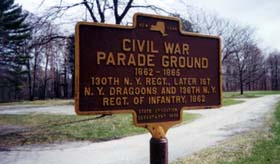 |
|
Photo by Tom Breslin |
The second of two Civil War units was organized on the Parade Grounds at Camp Williams on September 1st of 1862. This new unit was the 136th NY Infantry. This unit was made up of volunteers from Allegany, Livingston, and Wyoming Counties.
The Castile Historical Society provided us with documents related to the unit including one titled "Historical Sketch of the 136th New York Infantry" written by L. C. Havens in 1934. In the conclusion Mr. Havens thanks the Park Commission for their interest shown in setting aside the "old drill field" as a memorial, which leads us to believe he delivered this as a paper at the dedication of the park area and afterward had it printed. The paper contains all the company rosters in the regiment.
Havens recounts that James Wood Jr. of Geneseo was commissioned as Colonel by New York and authorized to raise a regiment of ten companies. The pressure of war is evident in that they only trained for a few weeks before they boarded the train at Portage Station on October 2nd. They went directly to Washington DC and across the Potomac into Virginia where they encamped on Arlington Heights.
Their first engagement in a major effort was at Chancellorsville in the May 1863 battle that lasted five days. They then went into guard duty status at Brooks Station protecting railroad property until June 11 when they moved out of camp to march to Gettysburg where they were involved in the action there on Cemetery Ridge for the entire three days of that most famous engagement of the war.
Colonel Woods is quoted in the Haven paper describing the scene, " Our artillery replies, a most terrific cannonade, the recollection of which is burned in our memories, continues for two hours. Deadly missiles fill the air, the shells burst all around us. The fire of the enemy is concentrated on Cemetery Hill; suddenly the fire on our side ceases, not because it was silenced , but by order; Lee's attacking columns then emerge from yon woods on Seminary Ridge; gallantly they march to the assault; onward in battle array they come; their ranks are riddled by grape shot and shells from our artillery which reopened, and bullets from the muskets of our infantry. The scene is awfully grand, magnificently sublime; the rebels fall as autumnal leaves fall from a forest tree and cover the ground. No one but those who participated in it can appreciate this grand, awful and sublime scene."
It is not surprising that the most impressive monument to the 136th. is in Gettysburg on Taneytown Road, across the street from the National Cemetery and close to the visitor center.
The 136th then participated in the pursuit of Lee's army retreating back into Virginia. The regiment took part in battles at Wauhatchie, Lookout Mountain, Missionary Ridge and Chattanooga. They hurried to relieve Burnside's army at Knoxville. They then returned to Lookout Valley and remained there for the winter.
In May of 1864 they went with Sherman on his Atlanta campaign and were in the thick of the fight at Resaca Georgia May 15th. They battled at Peach Tree Creek in July and by the 22nd were within two miles of Atlanta. The siege of Atlanta lasted until September and the unit then guarded the city for ten weeks. They were with Sherman on his march to the sea and helped lay siege to Savannah where they remained a month. They turned north again in January of 1865 and marched through the Carolinas where their most noted engagements were at Averysboro, N.C and Bentonville N.C.. Their Colonel James Wood Jr. was promoted to Brigadier General and this event was reported in the Rochester Daily Democrat in the March 16, 1865 edition which noted " he is now with Sherman somewhere in the Carolinas, gallantly leading the brave men of his brigade."
They were in the Carolinas when word reached them of Lee's surrender at Appomattox. By May 24th they paraded down Pennsylvania Avenue in the final Grand Review, and were mustered out a couple weeks later on the 13th of June, 1865. The war was over and the nation would begin recovery.
In an article in the Perry Herald of July 1961 there is a description of the reunions held at Portage by the veterans of the Civil War that lists the attendees as members of the 136th, the 1st NY Dragoons, the 5th NY cavalry, and the 24th NY Battery. These reunions drew ten to fifteen thousand people to the area on the east end of the Erie High bridge where two hotels existed and the point where troops boarded the trains that took them south to fight.
 |
The boulder that marks the site now in Letchworth Park was dedicated in 1933 at the reunion.
Also see....
"Parade Ground Monument to the 1st New York Dragoons"
Sources
Tom Breslin